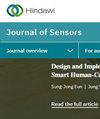Developing a Hybrid Irrigation System for Smart Agriculture Using IoT Sensors and Machine Learning in Sri Ganganagar, Rajasthan
IF 1.4
4区 工程技术
Q3 ENGINEERING, ELECTRICAL & ELECTRONIC
引用次数: 0
Abstract
The agriculture sector is one of the largest consumers of fresh water. Different types of irrigation systems are available, including center pivot, drip and sprinkler systems, and linear motion systems. However, the complex structure of existing irrigation systems and their high maintenance costs encourage Indian farmers to continue using these methods. Due to its ease of use and low energy consumption, surface irrigation is one of the most popular irrigation techniques. Although the main reasons for poor irrigation application efficiency are uneven irrigation water distribution and deep absorption, using a variety of technologies, countries are trying to increase the sustainability of agriculture. Automated irrigation systems contribute significantly to water conservation. The combination of automation and Internet of Things (IoT) improves agricultural practices. These technologies help farmers understand their crops, minimize their impact on the environment, and preserve resources. They also enable efficient monitoring of the weather, water resources, and soil. This research proposes an intelligent, low-cost field irrigation system. The proposed prototype can measure soil moisture, rain status, wind speed, water level, temperature, and humidity using a hardware sensor and unit. To decide whether to turn on or off the motor, a variety of sensors are used to get a range of readings and conclusions. They enable automatic watering when soil moisture levels are below a certain threshold, and if soil moisture is equal to the required moisture, then the irrigation process stops. Every few minutes, the sensors measure the environmental factors. Data are collected and stored on a ThingSpeak cloud server for analysis. To evaluate the data we collected, we used a variety of models, such as K-nearest neighbors (KNN), Naïve Bayes, random forest, and logistic regression. Compared to other Naïve Bayes and random forest models, the accuracy rate was 98.8%, the mean square error was 0.16, and the results of logistic regression, KNN, and SVM were in order: (98.3%/1.66), (99.3%/0.66), and (99.5%/0.5), respectively. In the end, an automated irrigation system run on IoT applications gives farmers access to remote monitoring and control, as well as information about the specifics of the irrigation field.在拉贾斯坦邦 Sri Ganganagar 利用物联网传感器和机器学习开发智能农业混合灌溉系统
农业是淡水消耗量最大的行业之一。灌溉系统的类型多种多样,包括中心枢轴、滴灌和喷灌系统以及直线运动系统。然而,现有灌溉系统结构复杂,维护成本高昂,促使印度农民继续使用这些方法。地表灌溉由于使用方便、能耗低,是最受欢迎的灌溉技术之一。虽然灌溉水分配不均和深层吸收是造成灌溉效率低下的主要原因,但各国正在利用各种技术努力提高农业的可持续性。自动化灌溉系统为节水做出了巨大贡献。自动化与物联网(IoT)的结合改善了农业实践。这些技术有助于农民了解作物,最大限度地减少对环境的影响,保护资源。它们还能有效监测天气、水资源和土壤。这项研究提出了一种智能、低成本的田间灌溉系统。所提出的原型可通过硬件传感器和装置测量土壤湿度、雨水状况、风速、水位、温度和湿度。为了决定是否打开或关闭电机,需要使用各种传感器来获得一系列读数和结论。当土壤湿度低于某个临界值时,它们就会自动浇水;如果土壤湿度等于所需的湿度,灌溉过程就会停止。每隔几分钟,传感器就会测量一次环境因素。数据收集后存储在 ThingSpeak 云服务器上,以供分析。为了评估所收集的数据,我们使用了多种模型,如 K 最近邻(KNN)、奈夫贝叶斯、随机森林和逻辑回归。与其他 Naïve Bayes 和随机森林模型相比,其准确率为 98.8%,均方误差为 0.16,逻辑回归、KNN 和 SVM 的结果依次为:(98.3%/1.66)、(99.3%/0.66)和(99.5%/0.5)。最后,在物联网应用上运行的自动灌溉系统为农民提供了远程监测和控制的机会,以及有关灌溉领域具体情况的信息。
本文章由计算机程序翻译,如有差异,请以英文原文为准。
求助全文
约1分钟内获得全文
求助全文
来源期刊

Journal of Sensors
ENGINEERING, ELECTRICAL & ELECTRONIC-INSTRUMENTS & INSTRUMENTATION
CiteScore
4.10
自引率
5.30%
发文量
833
审稿时长
18 weeks
期刊介绍:
Journal of Sensors publishes papers related to all aspects of sensors, from their theory and design, to the applications of complete sensing devices. All classes of sensor are covered, including acoustic, biological, chemical, electronic, electromagnetic (including optical), mechanical, proximity, and thermal. Submissions relating to wearable, implantable, and remote sensing devices are encouraged.
Envisaged applications include, but are not limited to:
-Medical, healthcare, and lifestyle monitoring
-Environmental and atmospheric monitoring
-Sensing for engineering, manufacturing and processing industries
-Transportation, navigation, and geolocation
-Vision, perception, and sensing for robots and UAVs
The journal welcomes articles that, as well as the sensor technology itself, consider the practical aspects of modern sensor implementation, such as networking, communications, signal processing, and data management.
As well as original research, the Journal of Sensors also publishes focused review articles that examine the state of the art, identify emerging trends, and suggest future directions for developing fields.
 求助内容:
求助内容: 应助结果提醒方式:
应助结果提醒方式:


